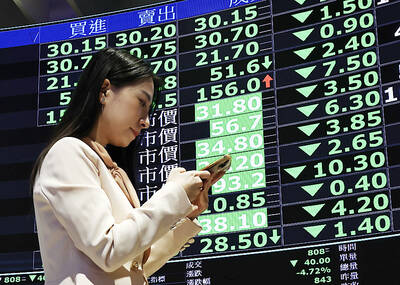The semiconductor industry is expected to grow at an anemic 2 percent annually this year as demand for cell phones shrinks amid a stuttering macroeconomy and prolonged inventory correction, Taiwan Semiconductor Industry Association (TSIA, 台灣半導體產業協會) said yesterday.
Taiwan might lag behind its global peers in expanding revenue as industry association SEMI expects global semiconductor industry revenue to rise by between 2 percent and 4 percent annually this year.
“The second half is likely to be a tougher period for Taiwan’s semiconductor industry than in the first half, as orders next month look to be slower than the seasonal level,” TSIA director-general Nicky Lu (盧超群) told reporters on the sideline of the opening ceremony of the annual semiconductor trade show in Taipei.
“We are pinning hopes on Christmas holiday demand from the US to boost business… We are also closely monitoring if China and India can sustain high GDP growth rate this year,” Lu said.
Another negative factor is that inventory on the supply chain remains high and might take another one to two quarters to digest, said Lu, who is chairman of chip designer Etron Technology Inc (鈺創).
Semiconductor inspection tool and equipment maker Hermes Microvision Inc (漢微科) chairman Hsu Chin-jung (許金榮) yesterday maintained a conservative outlook for the remainder of the year.
“In the second half, demand is falling short of expectations. There is some excess inventory in the supply chain. The global economy faces a challenge to pick up growth and develop new products,” Hsu said.
However, a slowdown is unlikely to be as severe as the 2008-2009 global financial crisis, Hsu said.
The Industrial Technology Research Institute (ITRI, 工研院) forecast the local semiconductor industry would post NT$2.25 trillion (US$68.68 billion) in revenue this year, up 2 percent from last year’s NT$2.2 trillion.
The forecast, a downward revision from a previous estimate of 9 percent growth, came as local chip designers, chip packagers and testers, and memorychip makers are predicted to see revenue contract this year, despite robust foundry segment growth of 11 percent annually, according to ITRI.
ITRI semiconductor analyst Jerry Peng (彭茂榮) said he might further cut the overall semiconductor industry’s growth forecast this year to 0.5 percent annually, or even to a negative reading, blaming a faster-than-expected decline in PC and handset demand.
The semiconductor industry might post its first annual decline in revenue since 2011, when revenue contracted by 12 percent year-on-year, according to ITRI.
The annual Semicon Taiwan trade show is expected to attract a record number of 43,000 visitors this year. The show began yesterday and is to run through tomorrow at the Taipei World Trade Center Nangang Exhibition Hall.

TARIFFS: The global ‘panic atmosphere remains strong,’ and foreign investors have continued to sell their holdings since the start of the year, the Ministry of Finance said The government yesterday authorized the activation of its NT$500 billion (US$15.15 billion) National Stabilization Fund (NSF) to prop up the local stock market after two days of sharp falls in reaction to US President Donald Trump’s new import tariffs. The Ministry of Finance said in a statement after the market close that the steering committee of the fund had been given the go-ahead to intervene in the market to bolster Taiwanese shares in a time of crisis. The fund has been authorized to use its assets “to carry out market stabilization tasks as appropriate to maintain the stability of Taiwan’s

STEEP DECLINE: Yesterday’s drop was the third-steepest in its history, the steepest being Monday’s drop in the wake of the tariff announcement on Wednesday last week Taiwanese stocks continued their heavy sell-off yesterday, as concerns over US tariffs and unwinding of leveraged bets weighed on the market. The benchmark TAIEX plunged 1,068.19 points, or 5.79 percent, to 17,391.76, notching the biggest drop among Asian peers as it hit a 15-month low. The decline came even after the government on late Tuesday authorized the NT$500 billion (US$15.2 billion) National Stabilization Fund (國安基金) to step in to buoy the market amid investors’ worries over tariffs imposed by US President Donald Trump. Yesterday’s decline was the third-steepest in its history, trailing only the declines of 2,065.87 points on Monday and

TARIFF CONCERNS: The chipmaker cited global uncertainty from US tariffs and a weakening economic outlook, but said its Singapore expansion remains on track Vanguard International Semiconductor Corp (世界先進), a foundry service provider specializing in producing power management and display driver chips, yesterday withdrew its full-year revenue projection of moderate growth for this year, as escalating US tariff tensions raised uncertainty and concern about a potential economic recession. The Hsinchu-based chipmaker in February said revenues this year would grow mildly from last year based on improving supply chain inventory levels and market demand. At the time, it also anticipated gradual quarter revenue growth. However, the US’ sweeping tariff policy has upended the industry’s supply chains and weakened economic prospects for the world economy, it said. “Now

Six years ago, LVMH’s billionaire CEO Bernard Arnault and US President Donald Trump cut the blue ribbon on a factory in rural Texas that would make designer handbags for Louis Vuitton, one of the world’s best-known luxury brands. However, since the high-profile opening, the factory has faced a host of problems limiting production, 11 former Louis Vuitton employees said. The site has consistently ranked among the worst-performing for Louis Vuitton globally, “significantly” underperforming other facilities, said three former Louis Vuitton workers and a senior industry source, who cited internal rankings shared with staff. The plant’s problems — which have not